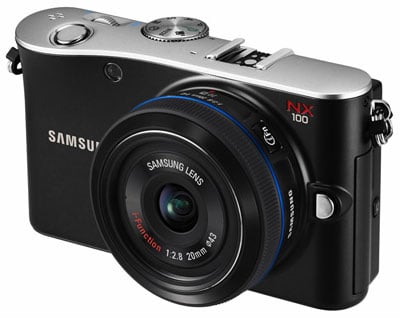Samsung’s NX100 is a small camera which features a DSLR-sized sensor and removeable lens mounting. Announced in September 2010, it becomes Samsung’s second NX camera, following the DSLR-styled NX10. The new model share the same concept as cameras like the Olympus E-P, Panasonic GF and Sony NEX series, which pack DSLR quality and flexibility into a much more portable form factor.
The NX100 shares a number of aspects with the NX10 before it including the same 14.6 Megapixel CMOS sensor and 3in VGA AMOLED screen. There’s no built-in flash, but there is a hotshoe, along with an accessory port below it which supports an optional EVF.
Samsung’s made a number of minor tweaks to the software allowing a greater degree of customisation, while the camera and two new kit lenses debut the company’s new i-Function feature. This allows you to customise the function of the manual focusing ring to adjust settings which include the aperture, shutter speed, exposure compensation, sensitivity and white balance. Once configured, you simply press and hold the iFn button on the side of the lens and twist the focusing ring to adjust.
We’ve been using a final production NX100 for some time and are pleased to share a selection of still images and HD movie clips taken with both the 18-55mm OIS and 20-50mm kit lenses. Scroll down for the movie clips, or head straight over to our Samsung NX100 sample images gallery to see the stills. Check back soon for a High ISO Noise comparison!
Here are a selection of sample videos filmed with the Samsung NX100 using its 18-55mm OIS and 20-50mm kit lenses and best-quality 720p movie mode. Registered members of Vimeo can download the original files by clicking the links below each window; these take you to the Vimeo page where the video is hosted and the link to download the actual file can be found under the ‘About this video’ section in the lower right. We used VLC Player to watch the MTS clips under Windows. Check out our Samsung NX100 sample image gallery to check the still imnage quality and come back soon for some High ISO Noise comparisons.
|
Samsung NX100 sample video 1: Outdoors, handheld panning with 18-55mm OIS |
|---|
|
|---|
|
|
|---|
|
Our first clip was filmed with the NX100 and 18-55mm OIS lens, zoomed-out to 18mm and with OIS enabled. As always, we’ve started on the bright watery reflections, which thanks to the camera’s CMOS sensor don’t suffer from vertical streaking. As we panned around, you’ll hear what sounds like a rockey taking off, but don’t be alarmed, it was just a very windy day. The stabilisation does a good job at eliminating any wobbles, but we didn’t attempt to zoom the lens at the end of the clip. You can see a similar clip filmed a few days earlier using the new 20-50mm unstabilised kit lens here.
|
Samsung NX100 sample video 2: Outdoors, tripod-mounted pan with 18-55mm OIS |
|---|
|
|---|
|
|
|---|
|
In our second clip, above, we’ve locked the NX100 to a tripod, disabled OIS on the 18-55mm lens and smoothly panned from left to right. There’s a fair degree of detail, although some undesirable coloured moiré effects around the finest building details which spoil the clip if you’re looking closely.
|
Samsung NX100 sample video 3: Indoors, dim light, handheld pan with 18-55mm OIS |
|---|
|
|---|
|
|
|---|
|
Moving on, our third clip above was filmed handheld in a relatively dim bar with OIS enabled. The clip is fairly clean and the stabilisation has ironed-out any wobbles, but unfortunately the colour moiré seen on the previous clip makes an appearance behind the bar. This may however be VLC’s decoding, so you may enjoy better results with different players. Note we have a similar clip filmed a few days earlier using the unstabilised 20-50mm lens here.
|
Samsung NX100 sample video 4: Indoors, Aperture Priority with manual focus and 18-55mm OIS |
|---|
|
|---|
|
|
|---|
|
For our final clip, we mounted the NX100 on a tripod, disabled OIS on the 18-55mm lens and switched to manual focus. We then set the NX100’s movie mode to Aperture Priority and selected the smallest f-number available before then ‘pulling-focus’ between the coffee cup and the background, and back again. The manual focusing rings on the Samsung NX lenses are sufficiently smooth for this to work very effectively, although you’ll really need to be mounted on a tripod for the best results. The camera’s high resolution screen, coupled with magnified assistance prior to filming, make it fairly easy to focus precisely on the desired subject – in this case, stopping at the chairs rather than the wall behind.




